-
Béla Tarr: The Turin Horse (2011)
BÉLA TARR: THE TURIN HORSE
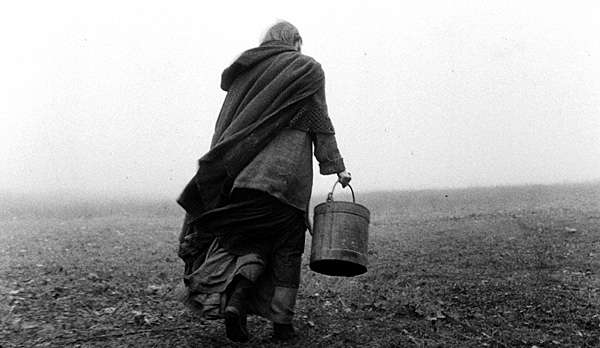
ERIKA BOK IN THE TURIN HORSE
Imagination dead imagine
The Hungarian director Béla Tarr is not for everyone. His style is distinctive. HIs venue is the film festival. He works in black and white, and at length. Great length. The subject is often people in remote places oppressed by dire weather. One of his masterpieces is Satantango (1994), about a village whose inhabitants are squabbling over cash: it's seven and a half hours. Werckmeister Harmonies (2000) concerns a town oppressed by frost, and villagers gathering outside a great exhibit of a whale carcass. Two and a half hours. The Turin Horse, which he declares will be his last film, also two and a half hours, concerns a bearded man, his dreary granddaughter, and a flea-bitten workhorse. They are out in the middle of nowhere, their primitive house and stable surrounded by howling winds. A dust storm rages, with a background of grinding strings swirling over a repeated cluster of notes.
The pretext for The Turin Horse is an apocryphal story of Nietzsche in 1889, when he saw a cabman abusing his horse and intervened, throwing his arms around the pathetic steed. We know what happened to Nietzsche, but not what happened to the horse, says the film's intro. Tarr endeavors to correct that with six days in the lives of the cabman Ohlsdorfer (Janos Derzsi), his granddaughter (Erika Bok), and the poor beast. Tarr tells a tale of daily rituals, suffering, darkness, and attrition. Gypsies raid the well, and later it has gone dry. Deprived of water, Ohsdorfer and granddaughter pack up essentials and leave, pulling a cart. The horse, which has lately refused to move or eat, accompanies them. But a day later they return and unpack everything. Eventually the winds stop, but the lamps won't light, and the embers die out: no more fire or light. And still no water. Only liquor.
Ohsdorfer and the woman are like Hamm and Clov in Samuel Beckett's Endgame without the wit and glorious language and cosmic setting. This pair hardly talk, and when they do, they speak in grunts and expletives. The granddaughter helps Ohsdorfer dress and undress, gets water (when there is any), tends to the horse (perhaps), boils potatoes. One big potato each is their sole meal, eaten off a crude dish without utensils. When they have come back from their attempt to escape, Ohsdorfer sits and looks out the window. His granddaughter eventually stops eating. The horse looks bad, but is still alive.
The Turin Horse is an exercise in style and mood. It tells us nothing, but its slow movement and dark look stays with us after the film is over. None of this would work without the grinding cellos and other string instruments underlining everything with a sense of grim, noble determination.
Gus Van Sant has cited Béla Tarr as a "huge influence" on his later, more arthouse work, beginning with the slow-moving and stark Gerry, which concerns two lost young men in a desert wandering about hopelessly. Tarr takes us back to the primitive roots of film. But is he a good influence or a bad one? The Turin Horse is one of Tarr's grimmest, most minimal films. It seems to illustrate Samuel Johnson's motto uttered in Rasselas: "Human life is everywhere a state in which much is to be endured, and little to be enjoyed." Here, we don't get the benefit of Beckett's cosmic jokes, not in so many poetic words, anyway. Of course The Turin Horse, which also has a visitor whose monologue provides an indictment of the villagers and perhaps all humankind, but one that Ohsdorfer dismisses as sheer bunk, is full of symbols one can while away many delightful hours in interpreting.
Tarr is a metaphysical visionary whose viewpoint is very distinctive. The technical aspects of his films are impeccable. This film was shot in handsome black and white by cinematographer Fred Keleman (who also did The Man From London, NYFF 2007), distinctively scored by Mihály Víg and co-written by longtime Tarr collaborator László Krasznahorkai. Each "day" consists of a very few long takes, which are enlivened by Tarr's technique of following his characters around the convincingly weathered hovel (designed by Sandor Kallay) with a Steadicam.
The Man from Turin has been shown at major festivals, including Berlin (where it won the Silver Bear), Hong Kong,Moscow, and Toronto, and the New York Film Festival at Lincoln Center, where it was screened for this review. The Cinema Guild acquired U.S. distribution rights and plans to release the film theatrically this winter.
Last edited by Chris Knipp; 09-29-2011 at 09:31 PM.
-
Abel Ferrara: 4:44 Last Day on Earth (2011)
ABEL FERRARA: 4:44 LAST DAY ON EARTH (2011)
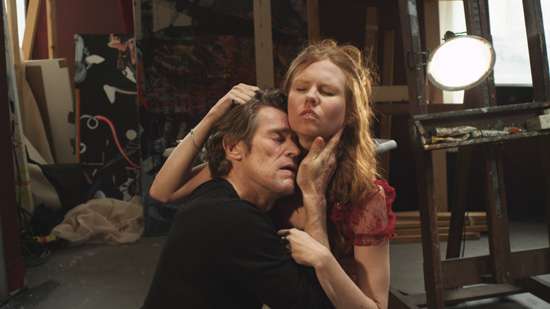
WILLEM DAFOE AND SHANYN LEIGHT IN 4:44 LAST DAY ON EARTH
Gore was right: let's talk on Skype
It's an ecodisaster: Gore was right, talking to Charlie Rose. So was the Dalai Lama. So were various other people seen on TV randomly in Willem Dafoe's loft apartment in New York as he hangs out with his girlfriend and talks to various people on Skype and in person, skipping over fire escapes to peek in on some friends whom he hasn't seen for some time.
The girlfriend paints bad Jackson Pollack knockoffs as they wait for the end. A TV anchorman excuses himself to go home to be with his family because, you see, this is the last day on earth. It's all going to explode, or something, later.
When you know the planet and all living things are finished, what do you do? Probably not spend your time with Cisco (Dafoe), a nervous worrier with nothing particularly interesting to say, or his young girlfriend Skye (Shanyn Leigh, the director's girlfriend), an insecure lass in pink silk pajamas (she later changes to a small dark dress) with artistic pretensions and jealous feelings toward Cisco's ex. One of the difficulties with dramatizing their efforts to make things right before the end is that we know little about them and less about their friends and family. For example, when Cisco arrives at his friends' apartment via fire escape and spends a little itme talking to them, we never quite learn who they are. There's a discussion of whether a man long in recovery from drug and alcohol addiction would want to go back to using now, since it's all over, so to speak. He doesn't. He wants to see the big bang bright and clear, not numbed by substances. Cisco isn't so sure. He thinks if there was ever a time to get high, it's now. This is a discussion that anyone in recovery would be familiar with.
Most of the screen time is spent at Cisco's loft studio apartment on the lower east side, where very little is happening, except for the mutimedia display provided by Ferrara's setup of computer, big screen TV, iPad, and other gadgetry. Cisco and Skye take refuge in sex for a while, which involved an up close squence of him caressing her naked arse and thighs that is very uncomfortable to watch. Again, the Skype farewells, when Cisco's to his ex-wife causes Skye to scream and grab Cisco and the laptop. Rarely have we seen such a dramatic Skype exchange. Come to think of it rarely have we seen so many Skype conversations in a film. The best Skype moment is provided by a Chinese food delivery boy who asks to Skype his family in China. We don't know what they're saying -- no subtitles are provided -- but when he kisses the screen, closes the laptop, and kisses it, then walks out bowing after his hosts have hugged him and given him money, it's clumsy, but also quite touching. Skye is prompted to appeal to her mother, also on Skype. In this role Anita Pallenberg briefly provides some European maturity and good taste.
Ferrara hits his technology/media theme hard, but not to great benefit.
This film looks pathetic when one has recently watched Part II of Von Trier's Melancholia, which achieves grandeur and solemnity with a similar theme. Ferrara's film suffers not so much from a lack of budget as from a lack of vision, lack of explanation for the apocalypse, lack of structure for the story, lack of plot and lack of interesting dialogue. Ferrara delivers a positive message about reuniting with loved ones at the end, but the context never gives it an emotional punch. There's a disaster here, but it's not the plot, it's the whole movie. 4:44 is as unfortunate as the selective New York Film Festival's main slate choices ever get.
Ferrara has his devoted fans, some of whom seem to be members of the New York Film Festival selection jury. His Go Go Tales, not appreciably better than this, was part of the 2007 NYFF. Ferrara at his best, as in King of New York (1990, with Christopher Walken), Bad Lieutenant (1992, with a fearless Harvey Keitel), and The Funeral (1996, again with Waken), is always chaotic, but the chaos in those films contains solid meat you don't find here. Fans will be glad that after a long break the director returns to his native NYC, but the film doesn't open up enough to make good use of the location. This time the chaos just seems like diffuseness, and even certainty of imminent death fails to focus the characters' thoughts sufficiently.
4:44 was shown at Venice and, as mentioned, the New York Film Festival at Lincoln Center, where it was screened for this review. It will be released commercially by IFC Films.
Last edited by Chris Knipp; 09-27-2011 at 07:45 PM.
-
Gerardo Naranjo: Miss Bala (2011)
GERARDO NARANJO: MISS BALA (2011)

STEPHANIE SIGMAN IN MISS BALA
Bird's eye view
Gerardo Naranjo's third film, Miss Bala, is all about point of view. He chooses to tell a tale of Mexican drug cartels and cop-gang war crabwise, from the angle of an innocent young woman whose only desire is to be a contestant in a local beauty contest. She is the pretty, sad-eyed Laura Guerrero (Stephanie Sigman), a 23-year-old from Tijuana who goes out one morning with her girlfriend Suzu to enter the competition for the title of "Miss Baja." Bala, bullet, is an ironic twist on that title. The gangsters who come in contact with her, particularly Lino Valdez (Noe Hernandez), a gang boss who survives a local police purge, force Laura to help them as a driver. He gives her her own gang name, "Carmelita."
Various virtuoso set pieces, elaborately staged for a largely static camera in very long takes that emphasize Laura's powerlessness over events, unroll while she is an unwilling witness, and sometimes a direct participant. To begin with, she and Suzu go from the beauty contest signup to a little party at a place called the Millennium Club where there are a bunch of men in uniforms dancing. They turn out to be American DEA agents and the party turns into a massacre -- the first of the set pieces, which will grow in violence and complexity: another one is a bullet-drenched police-gangster shootout in plain daylight, and the final one is another shootout when Laura is in a general's bedroom.
At the Millennium Club, Laura hides and survives but Suzu disappears. Laura comes around the next morning asking a cop to help her find Suzu, and he says he'll take her to the station to tell shat she saw. But instead she is delivered into the hands of Lino, and her unwilling collaboration begins. In return for it, Lino sees that she is reinstated as a contestant in the Miss Baja pageant, so her participation in this most frivolous aspect of Latin American life continues to be woven in and out of her involvement in revenge killings, acting as a decoy for an assassination, and helping to carry thousands of dollars and boxes of ammunition and weapons across the Mexico-US border in dealings with the US syndicate, which they refer to as "La Vaca." The gang Lino is in is called Estella. Lino apparently arranges to have Laura win the "Miss Baja" title -- since all is from her viewpoint, we never know the whys and wherefores -- which helps him, because it guarantees that Laura can gain the attention of the general Lino wants to killl and get her into his bedroom.
In nothing does Laura have a free hand. She is pushed here and there, and Miss Bala becomes a sort of picaresque tale whose heroine is neither quite innocent nor quite guilty. In this her role parallels that of the majority of ordinary Mexican citizens, who are drawn into the widespread criminality and violence willy-nilly. They may not know what's going on in their own backyards till it bites them in the face. And we have to strain to follow the elaborate gang war going on around Laura, because she doesn't understand it. She keeps escaping and getting caught again: Estella is omnipresent and omniscient.
This film has a strange kind of mood. It's an adventure, but there's something -- doubtless intentionally -- numbing and deeply sad as well as compelling about its thrills because of the way the narrative shows violence being absorbed into all of Mexican life. Again the carefully choreographed sequences done in a few long Steadicam shots contribute, providing a sense of detachment from the event, while also underlining that it has a life that is independent but also enveloping. The effect isn't flashy: it conveys a sense of powerlessness, not elation. At key moments the wide aspect ratio shot finds Laura's face in its dead center staring forward, sometimes numbly, sometimes weeping. (The film is shot in anamorphic 35mm.) These are the defining shots of the film, which still does read as an action film, but with one with a distinctive personal style that includes many moments of stillness, and thus is far from the precipitous loud action of the conventional thriller. The use of music is very restrained, but Pablo Lach's sound design is very effective in maintaining different a degree of menace even at quiet moments. The Hungarian cinematographer Matyas Erdely, a new collaborator for the director, contributes the look along with Naranjo's choreography of scenes.
Miss Bala delivers on the growing promise and complexity of his previous two films, Drama/Mex (LFF 2006) and I'm Gonna Explode (NYFF 2008). (There was a LA-shot first feature, the 2004 Malachance, which I haven't seen.) Miss Bala, which has already been picked up by Twentieth Century Fox after showings at Cannes and at Toronto and chosen by Mexico as its entry in this year's Oscar competition, is being compared to Heat and Scarface and called a ticket to Hollywood, should Naranjo want to migrate. (But what makes this film so good is everything that is non-Hollywood about it.) Peter Debruge of Variety (who noted the Hollywood potential) calls Miss Bala a "blistering firecracker." Diego Luna, speaking at the film's Mexico City premiere (and an executive producer with his pal Gael García Bernal), noted this film's relevance to its place and time and said "we are in the midst of a war that we wanted to believe was not affecting us." Naranjo tackles the very violent country that Mexico has become from a fresh angle and with a distinctive, quiet virtuosity.
As Mike D'Angelo noted with surprise in his Cannes coverage, the film was shown there out of competition. It was also shown at Toronto, and included in the New York Film Festival, where it was screened for this review It is scheduled for limited US release October 14, 2011 (Twentieth Century Fox), UK release October 28, and in France February 1, 2012.
Last edited by Chris Knipp; 11-07-2011 at 10:41 PM.
-
Roman Polanski: Carnage (2011)
ROMAN POLANSKI: CARNAGE (2011)
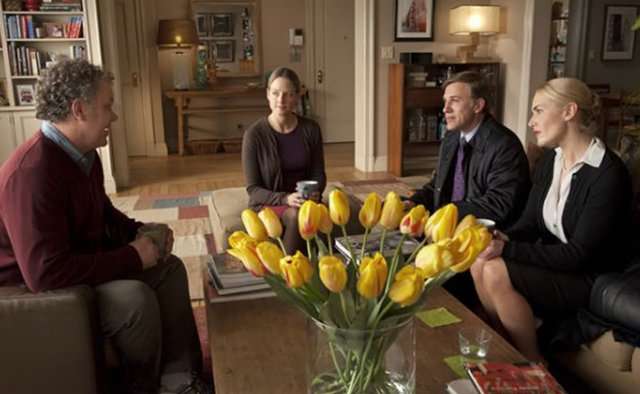
JOHN C. REILLY, JODIE FOSTER, CHRISTOPH WALTZ AND KATE WINSLET IN CARNAGE
Verbal blows in Brooklyn
In a way Polanski gets to do his Who's Afraid of Virginia Woolf in Carnage, as Mike Nichols got to do with Edward Albee's original play when he filmed it in 1966 -- though he hasn't got Liz Taylor and Richard Burton and this is not as rich and resonant a play. Here the ironies are a little too easy; they do not go deep enough. Carnage, the title trimmed down from the original The God of Carnage, which the director rewrote for the screen in collaboration with the French-born playwright, Yasmina Reza, is a drama in which two couples start out ever-so-polite and wind up Neanderthal. It's been described as a one-joke play. However, Polanski's direction neatly brings out the nuances of that joke and brightly tunes up the crescendo of blatant hostility between and among couples that comes in the last quarter of the 80-minute interaction. The director has done something like this before, with Death and the Maiden (1994), also from a play, by Ariel Dorfman. Which was the year of Art, Reza's previous London and New York hit (both plays produced from English translations by Christopher Hampton). This time Polanski made use of a more literal translation by Michael Katims.
Is this as good as Maiden? Maybe. As powerful as Virginia Woolf? Hardly. Is making a play as restricted as this to living room, kitchen and bath into a movie necessary? Debatable. (Polanski worked deftly in small spaces with The Tenant and Repulsion, but that was different, and more cinematic.) But one can argue that the activity is comparable to recording classical music instead of simply performing it live. There is a chance to get it absolutely right. There is the loss of the magic of stage and audience, but there is a precision, which fits Polanski's style very well. Given this kind of format, he delivers. And this time his technical staff conspire to make the action appear smooth and seamless in a way it cannot on stage.
This, like Virginia Woolf, is a four-hander, cast for the film with Christof Waltz and Kate Winslet as Kate and Allen Cowen, a corporate lawyer and an investment banker, and John C. Reilly and Jodie Foster as Michael and Penelope Longstreet, a hardware salesman and a writer and bookstore employee. Great casting. Not that they're necessarily better than James Gandolfini, Marcia Gay Harden, Jeff Daniels and Hope Davis, the quartet who took the roles on the stage in America. Reilly is goofy, where Gandolfini is menacing and Neanderthal from the start. Waltz is smooth and understated, where Daniels was annoying from the start. Foster is not just prissy but muscular. Winslet is a bit like that too. I found their voices too similar; perhaps Wislet, putting on an American accent, was subconsciously imitating Foster. Waltz stands out again as an actor of extraordinary versatility (thanks, Quentin); Foster is strong and amusing; Winslet is a slow burner; and Reilly neatly creeps up on you. Fine ensemble work here, no doubt about it.
The film begins with a long shot showing the violent incident between the two 11-year-old boys in Brooklyn Bridge Park that is not seen in the play; the interior action was all shot in Paris due to Polanski's legal problems in the US, but set in the vicinity of Brooklyn Heights. The Cowans' son Zachary hits the Longstreet's Ethan with a stick, resulting in the loss of two teeth. The Cowans come to visit the Longstreets to prepare a reconciliation between the two boys and by way of apology. Things begin in a polite, civilized manner, over apple-pear cobbler and coffee. As the evening wears on, whisky is drunk, and hostilities -- evident from the start -- grow stronger. Casualties include Kate Cowan's vomiting, which damages Penelope Longstreet's treasured art books; Kate throws her husband's ever-present cell phone into a vase of water; and she later trashes a beautiful arrangement of tulips that ornaments the coffee table.
I confess that the Broadway Gods of Carnage left me unmoved, quite specifically due to my memory of being shaken to the core by the original Broadway Virginia Woolf. It might have been interesting to see Isabelle Huppert in the Paris version, but I'm not sure. However you slice it, this is much ado over an 11-year-old's smashed incisor and it's not Pinter or Martin McDonagh. It is a pleasure to see Polanski's elegant and very well-directed version, but why has the New York Film Festival not chosen any Polanski film but this since Knife in the Water? What about Chinatown? The Pianist? Is this, like the Oscars, some belated gesture of recognition?
Carnage was shown at the Venice and New York film festivals, screened for this review at Lincoln Center. The gala opening night presentation of the NYFF. It will be a Christmas bauble for Americans, opening in theaters December 16, 2011 (Sony Classics). It opened rather widely in Italy September 19th (355 screens) and has done rather well.
Last edited by Chris Knipp; 09-29-2011 at 09:26 PM.
-
Asghar Farhadi: A Separation (2011)
ASGHAR FARHADI: A SEPARATION (2011)
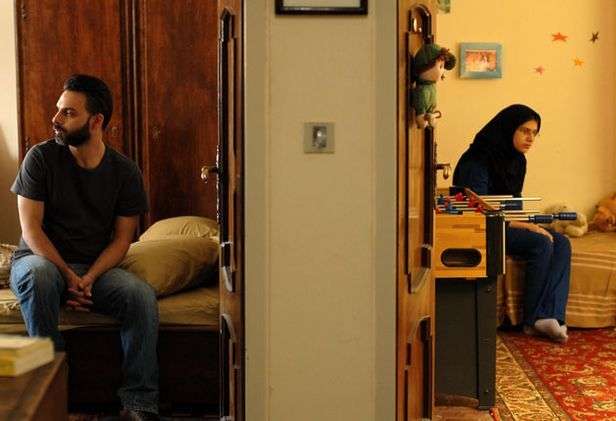
PEYMAN MOADI AND SARINA FARHARDI IN A SEPARATION
How everybody's wrong, and why
Jodaeiye Nader az Simin/Nader and Simin, a Separation is the full title of this new Iranian film that uses neorealist vérité style to weave a tangled skein of quarrels and legal problems (and implied class conflict) that occur when a secular middle-class family clashes with a more impoverished one after the better-off husband and wife choose to split up. Notable for an unusually intricate and well-worked-out plot that poses many moral issues while remaining curiously bloodless in human terms, Separation almost gets bogged down in the numbing specifics of telenovela-like daily melodrama at first as it sets up its basic issue. When if finally gets going the film takes on almost a mystery-story complexity and, if it's never quite resolved at the end, well, that's life. With this web of fault-finding and recriminations that somehow cancel each other out, in A Separation Asghar Farhadi may have made the quintessential Iranian film.
The basic setup, unfortunately also the least involving scene, shows Nader (Peyman Moadi), a bank employee, faceing the camera alongside his wife Simin (Leila Hatami) as a judge considers Simin's request for a divorce. She has had permission to emigrate for some time; its validity is soon to run out. She wants to take their teenage student daughter Termeh (Sarina Farhadi, the director's own daughter) out of the country for a better life. Nader refuses to go. He feels he must stay to care for his Alzheimer-sufferer father (Ali-Asghar Shahbazi). The judge finds Simin lacks sufficient reason for divorce. She is stuck in Tehran, but goes to stay with her mother (Shirin Yazdanbakhs). Termeh remains with dad and her senile grandfather, of whom she is fond.
To cope in Simin's absence, Nader hires the poor and devout Razieh (Sareh Bayat) to mind his father during the daytime, and Razieh brings her little girl (Kimia Hosseini). The film follows Razieh and her daughter only for several sequences when they're at Nader and Simin's apartment. Razieh turns out to be pregnant, and also unwell. She isn't really able to cope with an Alzheimer's patient and when he wets himself, has to call a religious advisor to know if it is lawful for her to help him clean up and change. When she isn't looking he escapes and goes out to the local newsstand. She goes off, chador flying, to find him and bring him back. A day or so later Nader returns to find Razieh and her daughter out and his father fallen on the floor unconscious with one arm tied to the bed. He and Termeh restore the old man to consciousness, afraid at first he might be dead. Nader finds some money missing. When Razieh returns, he fires her. She protests, claiming she had to go out and did nothing wrong, and in the altercation Nader grabs Razieh and pushes her out.
The next day he learns Razieh is in the hospital and has had a miscarriage. Simon and Nader, who reconnect to deal with this emergency, go to see her. They encounter Hodjat (Shahab Hosseini), Razieh's short-fuse husband, who has met Nader but didn't know his wife was working in a strange man's house and caring for another strange man, and would never have allowed it. Before you know it we're back in front of a judge in a crowded police station, with Nader accused of murdering Razieh's unborn son (she was 4 1/2 months pregnant) and Nader counter-charging Razieh with assaulting his father.
This is essentially where the film begins as claims go back and forth and the points of view become increasingly complicated. One issue is whether Nader knew Razieh was pregnant, and the testimony of Termeh's female tutor (Merila Zarei), who had a conversation when Razieh first arrived that Nader may or may not have heard, becomes key. Another issue is: did Nader knock Razieh down the stairs, or did she fall? Neighbors testify. And then: What caused the miscarriage? Did the violent Hodjat (who's already come to blows with Nader) hit her? He has been in and out of prison due to debts, is out of work, and is at his wit's end. His angry vociferation clouds every meeting.
A Separation is a realistic picture of a culture in which everyone is quarrelsome and out of sorts, everyone finds fault with everyone else (with the exception of a few sacred parental and filial family relationships), and everyone lies -- but both secular and religious values have strong positive sides. Nader is stubborn and macho, but also surprisingly open in offering his wife and daughter the choice of how to act. And call it religion or superstition, but though Razieh may lie, she is not willing to do so under oath, for fear of dire consequences from God.
The virtue of this film as of many contemporary Iranian ones is the way it is completely rooted in believable quotidian details. And the main actors, whom Farhadi, whose original background was in theater, had thoroughly coached and conditioned, are quite convincing even if their characters remain opaque and unsympathetic. The claim by some that this is a kind of "Rashomon" seems, on the other hand, quite absurd: the camera sticks very close to Nader's point of view and rarely has scenes without him. The strategy is to follow one event after another in the legal wrangling for what it may reveal of new evidence and new testimony. At one point Nader is in jail and must be bailed out by Simin, and he might be sentenced to from one to three years in prison. But this isn't a film about character so much as about legal, moral, and religious issues. The strategy of constantly revealing new details or accusations may seem irritating, but it keeps your attention and builds up energy, even though a sense of overarching structure is, perhaps intentionally, lacking.
A Separation has won praise for its ingenious plotting. It's a kind of puzzle-film, more intricate than suspenseful (the comparison with Hitchcock is as silly as the one with Kurosawa) -- and with a tension that dissipates rather than is resolved. In addition to being ingeniously plotted and well-acted, however, it's good looking by Iranian standards, with handsome, if sometimes jerky, camerawork by d.p. Mahmood Kalari, who's a mean man with a yellow filter.
Though his name is new to some of us (including me) this is the 39-year-old Farhadi's fifth film, and he has won prizes before, particularly for his 2009 About Elly. A Separation has been shown in a raft of international film festivals, starting with the Berlinale in February 2011, where it won the Golden Bear and the Best Actor and Best Actress awards, and ending with Rio and the New York Film Festival, where it was screened for this review. It has been or will be released in a dozen countries, with limited US release (Sony Pictures Classics) coming December 30, 2011.
Last edited by Chris Knipp; 09-29-2011 at 11:43 PM.
-
Santiago Mitre: The Student (2011)
SANTIAGO MITRE: THE STUDENT (2011)
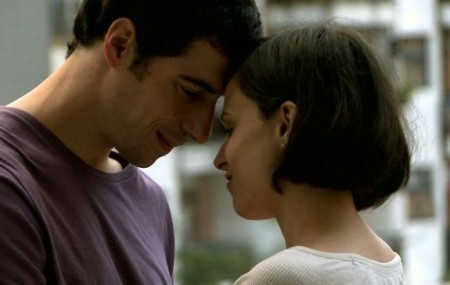
ESTEBAN LAMOTHE AND RICARDO FELIX IN THE STUDENT
Macchiavelli in academia
In this present-time tale that might have unfolded in any of the last five decades, the smooth-talking Roque Espinosa (Esteban Lamothe) returns to the University of Buenos Aires from his rural hometown for the third try, having begun studies there before in two different schools and dropped out. This time he finds his real areas of specialization: women and politics, in that order at first; politics, never an interest of his before, takes the lead once he's found a political activist girlfriend who's a low-level faculty member. Largely through Paula (Romina Paula) he learns how adept he is at using his people skills as a political fixer, organizing a grassroots protest and an assembly and meeting sub rosa with high officials to help a professor friend maneuvering to win an election. But that adeptness betrays him. His final and most important word in the film's closing image is a "No" that probably is the beginning of his real life.
A recurrent voiceover introduces us to the politically naive Roque as he enters the campus, full of political graffiti and slogans and words that are going to become his daily bread in a while, but at first are a mystery. He doesn't know what the talk of political parties or curriculum reform is all about at first, but he's more attracted to Paula, who gives a confident political speech, than Valeria (Valeria Correa), the less cute girl he's bedded since arrival. He's a bit of a Casanova, a quality that doubtless adds to his political charisma as time goes on. He soon becomes fascinated not only with Paula, but with the older Peronistas he meets through her, veterans of the 1970's "dirty war" who engage in dialectical conversations with the younger and more skeptical political leftists around the university, who gather plotting ways to gain control of an academic board. This material may elude some non-Argentine audiences, but would strike familiar cords for Europeans and other Latin Americans nonetheless, and seen simply as a picture of an election campaign's nitty-gritty aspects, is pretty universal.
What's lacking after the first few scenes, surprisingly, given that this is a university setting, is much focus on fundamental ideological and doctrinal issues. As Roque is befriended, and used, by a professor, the experienced politician and friend of Paula, Alberto Acevedo (Ricardo Felix), what seems to be going on is mainly just horse-trading to gain position and win elections, and we lose sight of what makes all this worthwhile, other than gaining Roque a respect among members of his chosen university party that, it turns out, can be easily lost. What does come through loud and clear is Roque's eventual disillusion when he realizes despite being given good jobs to do for a newcomer, in the end he's just a pawn in a game he doesn't control or understand.
Argentine writer-director Santiago Mitre's El estudiante is a study of university politics that's richly detailed and specific. So much so that, particularly if one is reading the fast appearing and disappearing English subtitles, it's sometimes hard to follow. And it tends to overwhelm its protagonist, Roque, who is less interesting than the machinations he becomes a part of. We might say the same for the director. Discovering his own skill at anatomizing the bait-and-switch schemes of leftist academics arranging to win key posts, Mitre gets in a bit over his head, as Roque does, losing sight of his film's need to breathe a bit. But no matter. People are starved at some level for this kind of thing. Accurate depictions of politics of any kind are rare. The Student has won admiration and attracted filmgoers in many countries already.
And this is not to fault Esteban Lemothe, the lead, or Mitre. Lamothe is an interesting actor, energetic and sexy without being really handsome, suave yet not quite sophisticated. He's a little like Malik Zidi in Emmanuel Bourdieu's Poison Friends (NYFF 2006), another film about a university student's disillusionment. And Mitre, who has written two screenplays for Pablo Trapero, Lion's Den and Carancho, knows how to build moral unease and maintain an intense pace. Los Natas' score, heavy on strings and drums, is good at maintaining the sense of youthful excitement, and creates a wonderful mood of disenchantment in the last scene. The team camerawork is good at maintaining a sense of Roque's point of view in crowded shots. For all its weaknesses, this is a lively and vivid film with a fresh subject. I see his point, but I don't find this "dry and inconsequential" as Mike D'angelo did, writing from Toronto.
Indiewire trumpets Mitre as "a South American Aaron Sorkin," and this film does make one think of Sorkin's White House and presidential campaign saga created for American television, "The West Wing." But Sorkin is way more in control of his material, and that allows him to entertain and develop character while unfolding his political intrigues from multiple viewpoints. These are skills that elude Mitre, who sticks doggedly to the POV of Roque, so doggedly that things are more wearing than witty in the Sorkin manner, though the film still delivers intense, compelling stuff. It's fun trying to keep up with all the endless political talk. When it's over, though, The Student may seem a bit short on memorable moments.
The Student debuted at the Buenos Aires festival in April 2011 and was shown later at Toronto and Hamburg and the New York Film Festival at Lincoln Center, where it was screened for this review.
Last edited by Chris Knipp; 04-12-2019 at 10:58 PM.
-
Ullrich Köhler: Sleeping Sickness (2011)
ULLRICH KÖHLER: SLEEPING SICKNESS (2011)
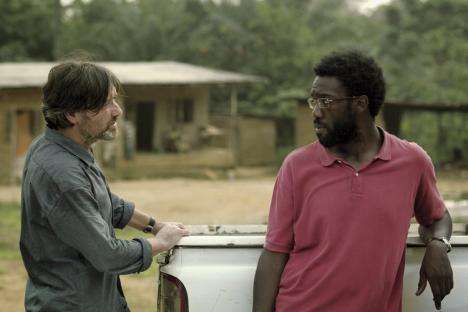
PIERRE BOKMA AND JEAN-CHRISTOPHE FOLLY IN SLEEPING SICKNESS
Up river
The German director Ulrich Köhler's third film, Schlafkrankheit in the original, is about Africa, where he lived happily as a boy, by his own account, when his parents were European medical relief personel in the Congo. His film is in two parts, which don't mesh particularly well. The first part is about a Dutch-born doctor, Ebbo Velten (Pierre Bokma), who's been in Cameroon too long and says goodbye to his German wife (Jenny Schily) and teenage daughter (Maria Elise Miller), but can't bring himself to leave. The Mr. Kurtz analogy would be excessive: the locals seem quite tame, for one thing -- but Velten has become one of those culturally split personalities who can't quite fit in in either world, this one or the one he left a long time ago. The second half comes three years later when Alex Nzila (Jean-Christophe Folly), a young French doctor of Congolese descent who's lived all his life in Paris, arrives on his first assignment from WHO to do an assessment of Velten's local program to eradicate sleeping sickness. Good performances, believable incidents, and totally authentic locales don't make this come together as a well-made film. It becomes increasingly unfulfilling as it progresses. The writing and editing are at fault here, but Sleeping Sickness won a festival slot (and even a Silver Bear award at the Berlinale for Köhler's direction) through its interesting and lived-in subject matter and atmosphere.
Velten loves his German wife, but an unappetizing bed scene shows their sex life may have died out. Yet when Gaspard (Hippolyte Girardot) suggests he join up for some play with pretty young African women, he declines. That has changed when the screen goes black and the narrative resumes, three years later, focused on Dr. Nzila and France. Velten's interest in African women has developed now, three years later, when Dr. Nzila arrives in Cameroon to do the WHO evaluation. Things are rough for Nzila: even getting from the airport is a huge hassle. By now, it turns out, Velten has a young African wife about to have a baby. Velten is off somewhere, his underlings covering for him as Nzila frantically waits. Nzila is even called on to perform a Cesarian section, which he has never done and doesn't even have the stomach for. And then he gets sick. Nzila goes through a series of scenes that are vivid images of a westerner plunged into a primitive setting and far out of his depth. He's also treated differently because he's black, dumped off at a hovel in the dark of night when he first arrives.
When Velten finally shows up several days later, treating the ill Nzila and performing the cesarian, which turns out to be on his wife, it also gradually becomes clear that sleeping sickness has been so nearly eradicated through Velten's good offices that the program and funding aren't needed. We've already seen in the first part of the film that Velten acknowledges this but local bureaucrats want more funding, not less. Velten isn't really needed either, most likely. He's trained the locals, and done himself out of a job. But of course he has no life elsewhere. What is Nzila to do?
That question is never really answered. Köhler takes Gaspard, Velten, and Nzila hunting by night along a river, and we get a whiff of a Heart of Darkness situation as Nzila becomes terrified and is separated from the other men. The film's ending is open-ended, which is fine, except that the contrast between Velten and Nzila, who are obviously polar opposites of the colonial spectrum, is never developed in an interesting or revealing way. Velten has a certain sleazy charisma. But it's the first shocking days of Nzila's mission that leave the most vivid impressions. In his final moment, after a night alone, he comes to the river's edge dazed and is pushed into a long rowboat. Gaspard and Velten are nowhere to be seen, and as the boat slips away a large, menacing hippo appears. It's a memorable moment -- this film has a few -- but a completely ambiguous one.
It's hard not to compare this with Claire Denis's White Material, also a treatment of Europeans in Africa whose time has run out. Though Denis isn't at her best in that film, it certainly develops the whole colonial-African context far more clearly and richly. Köhler's specific local details are very convincing, more intimate and real in an everyday sense than Denis', but he doesn't do enough with them. Denis' Africa may be more mythological and generalized, but it's also more resonant.
Sleeping Sickness debuted at Berlin in February 2011, and was released in Germany, the Netherlands and Poland in June, July and August, respectively. It was chosen to be part of the New York Film Festival in October, and it was screened there for this review.
Last edited by Chris Knipp; 04-12-2019 at 06:05 PM.
 Posting Permissions
Posting Permissions
- You may not post new threads
- You may not post replies
- You may not post attachments
- You may not edit your posts
-
Forum Rules





 Reply With Quote
Reply With Quote






Bookmarks